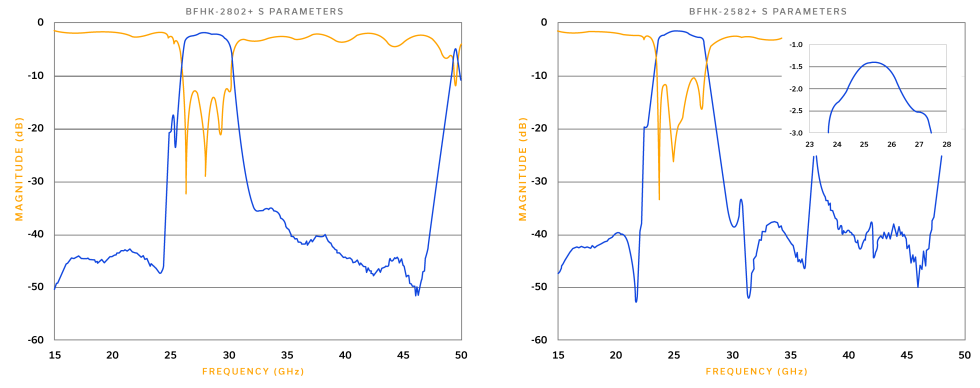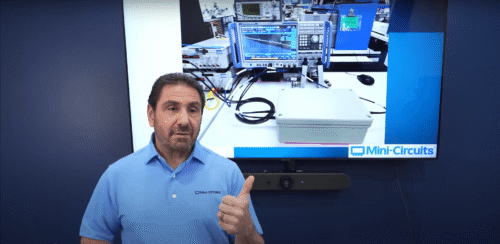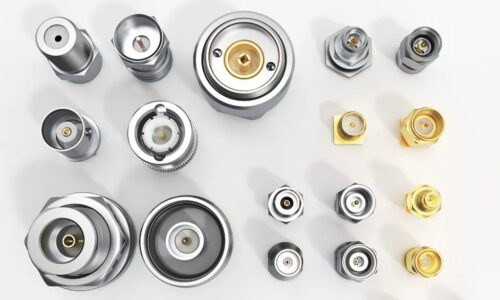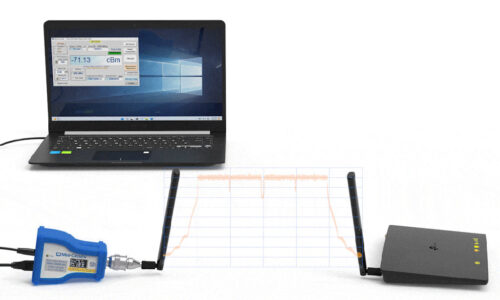LTCC Meets 5G: Advanced Filter Designs Achieve True mmWave Performance
Low Temperature Co-fired Ceramic (LTCC) substrate technology is one major area of Mini-Circuits’ R&D investment. As a result of its long-term investments in materials, manufacturing processes, simulation and testing capability, research on novel circuit topologies, and world-class engineering talent, the company has developed a new series of filters based on LTCC technology that support the millimeter wave (mmWave) 5G market with a small footprint, low cost, and superior performance to competitive products and technologies. This includes the newly developed bandpass filters specifically designed for the 5G FR2 n257, n258, n260 and n261 bandwidths, low pass filters supporting bandwidths from DC up to 30 GHz and beyond, and high pass filters with passband cut-offs up to 36 GHz at the time of this writing.
These filters represent a revolutionary advance in the capability not just of Mini-Circuits’ portfolio, but of the state of the art for LTCC technology. Traditional implementations of LTCC limited operating frequencies to 10 GHz and below. With over twenty years of accumulated knowledge and design experience, Mini-Circuits has combined innovations in materials sciences, circuit topologies, and fabrication processes to completely redefine what’s possible for RF components on LTCC substrates. Mini-Circuits now offers the broadest portfolio of millimeter-wave LTCC components in the world, offering many valuable benefits for system designers working in high frequency applications.
LTCC Technology Benefits
Currently, surface mount millimeter wave filters are often designed using thin film on alumina technologies. Thin film achieves good performance in the desired passbands but is much larger in size and more expensive than LTCC. A typical thin film on alumina filter might have a footprint size of a square quarter inch, a significant sacrifice of board real estate for a discrete function. Thin film filters also typically quite sensitive to their surroundings, which makes them susceptible to detuning once they are assembled onto a channelized board layout, which is common in 5G small cell architectures.
By contrast, LTCC filters are very small in size, low cost, and robust without similar risk of performance deviation due to environmental factors. Mini-Circuits’ LTCC technology has a proprietary internally shielded structure within the filter that prevents the de-tuning of the filter after assembly without the need for additional shielding. These products also employ proprietary conductive pastes along with distributed filter topologies to achieve repeatability at higher frequencies comparable to that of thin-film processes.
Until recently, the benefits of LTCC were limited to lower frequency applications, generally below about 10 GHz. That perception remains in the marketplace in large part, leaving unmet need for small, affordable, robust surface mount filters for millimeter-wave systems. Mini-Circuits has addressed that need with a number of innovations. First, the design team developed proprietary material systems that achieve smoother surface substrates, which cut down on losses and irregular impedance transitions at high frequencies. Additionally, photolithographic process used for printing conductors on the LTCC substrate have much tighter tolerances for the line widths than conventional screen-printing techniques. This enables finer and more complex structures on the LTCC substrate with smaller dimensions. These LTCC material enhancements both increase the relative permittivity and reduce the loss tangent.
Additionally, Mini-Circuits has developed a proprietary case style that aids in achieving better performance and preventing de-tunning, especially at higher frequencies. The packaged filter also supports standard coplanar launches, which minimizes transition discontinuities over frequency. These advances allow LTCC to compete with alumina substrate technology from a performance standpoint, while providing distinct advantages in terms of size, cost, and manufacturability. The surface mount (SMT) packaging options for Mini-Circuits’ millimeter wave 5G band pass and low filters are shown in Figure 1. Mini-Circuits has applied quality standards based on MIL specifications in qualifying these 5G filters to guarantee high quality and reliability for a wide variety of harsh operating conditions.
Figure 1: SMT packaging options for Mini-Circuits’ 5G millimeter wave band pass and low pass filters.
Mini-Circuits Millimeter-Wave LTCC Filter Products
Bandpass Filters
Mini-Circuits is developing its LTCC filter portfolio based on demand for millimeter wave passbands supporting 5G FR2 bandwidths. Table 1 shows models currently available from stock for these bands. Additional models are currently in development and custom designs for special requirements are available on request.
Table 1: Mini-Circuits’ LTCC band pass filters for 5G FR2 bands.
Part Number
3 dB Passband Cutoff (GHz)
Case Size
The S21 frequency response for the BFHK-2802+ bandpass filter is shown on the left-hand side of Figure 2. This model is ideal for the 5G n257 band. The S21 frequency response for the BFHK-2582+ bandpass filter is shown on the right-hand side of Figure 2. This model is designed for the 5G n258 band. BFHK-series models feature a 1812 (4.5 x 3.2 mm) form factor, which is a standard format for pick-and-place assembly.

The BFCQ series of bandpass filters achieve similar millimeter-wave performance to that of the BFHK series, but in an even smaller, 1008 package (2.5 x 2.0 mm). The S21 frequency response for the BFCQ-3852A+ bandpass filter is shown in Figure 3. The passband insertion loss of the filter is measured to be < 2 dB. This model is designed for applications in the 5G n260 band.

Low Pass Filters
In addition to the band pass filters described above, Mini-Circuits has also developed a series of LTCC low pass filters that extend to millimeter wave frequencies. While millimeter wave bandpass filters typically focus on frequency tuned applications, low pass filters can be used for wideband systems. Figure 4 shows the S21 frequency response of 5 filters in the low pass filter family. The passband low end for each low pass filter is DC by definition. The 3 dB bandwidth for the 5 filters are shown in Table 2:
Table 2: Mini-Circuits’ millimeter wave LTCC low pass filters.
Part Number
3 dB Passband Cutoff (GHz)
Case Size

Mini-Circuits LTCC Substrate Integrated Waveguide (SIW) Filter Product
The groundbreaking performance of the models discussed above was made possible by a combination of all the innovations we’ve mentioned, one of which is the implementation of distributed circuit topologies. Further to the advances achieved in the models described above using planar topologies, Mini-Circuits is the first in the industry to develop a substrate integrated waveguide (SIW) filter on LTCC substrate. This structure results in a narrow bandpass response at millimeter wave frequencies. Fractional bandwidth narrower than 10% can be achieved at millimeter wave frequencies with an insertion loss (IL) of < 2 dB. This characteristic allows the development of filters for highly targeted passbands in crowded regions of the frequency spectrum.
The BFCV-2852+ is a millimeter-wave bandpass filter based on the SIW topology on LTCC. The S21 plot over frequency is shown on the left-hand side of Figure 5. The right-hand plot is a close-up on the S21 frequency response in the pass band showing insertion loss in the passband of < 2 dB. This LTCC filter performance is also achieved in a low cost, ultra-compact 1210 SMT package.

Mini-Circuits Filter Applications
For millimeter wave 5G, back-haul, and military applications, Mini-Circuits LTCC filters can be leveraged as solutions for tight constraints on space, cost, and performance. For example, shown in Figure 4 is a small, 2 X 2 antenna array with the supporting millimeter wave transceiver electronics. The application shown is half-duplex where the transmit and receive frequency bands are identical. It should be noted that for this type of application, the insertion loss of the filter has a direct impact on the overall noise figure (NF) and link budget for the transceiver.
Packaging is a particular challenge for this application. The antenna array must interface to a small filter bank without taking up too much area before going to the transceiver electronics. As the array size increases, this problem becomes exponentially more difficult. Alternately, if the 2 X 2 array required full duplex operation with the transmit and receive channels operating in different frequency bands, this example becomes an even more complex and difficult filtering problem. This is where Mini-Circuits’ LTCC designs come in with small, compact footprint filters that can be channelized without compromising the isolation performance. For military phased array radar applications, where the array size can comprise thousands of elements, the bandpass and low pass filters can provide a low cost and small footprint solution without compromising performance. The filters can also be utilized in typical millimeter wave transceiver line-ups and provide reduced channel size compared to competing connectorized filters. Smaller footprints translate to more channels in a given volume-constrained solution. This opens up a solution space that was previously not a possibility to consider.

These same advantages apply to 5G small cell architectures where filters are needed between massive MIMO antenna arrays and transceiver ICs, allowing reduction of overall board size without compromising performance.
Conclusion
Mini-Circuits has developed a unique LTCC technology for millimeter wave applications with a set of features that enables a filter product line with low cost, small form factor, and state-of-the-art filter frequency response without the need for tuning. These filters will enable applications that were previously not possible due to size constraints. Mini-Circuits will continue to develop and enhance the LTCC technology and new products for future high frequency applications beyond those shown here. Future LTCC filter products will include monolithic structures with integrated baluns for RF sampling data converter and analog / mixed signal applications. Look for these new product releases in the coming months.
Learn more about Mini-Circuits mmWave LTCC filters on our website or contact our engineers to discuss your application requirements.











